Smart Technologies for Sustainable Water Management: An Urban Analysis
Abstract
:1. Introduction
- RQ#1: Which are the major smart technologies used for water management, focusing on freshwater consumption and pollution, at an urban level?
- RQ#2: How could these digital interventions foster urban water management in an efficient and sustainable manner?
2. Research Methodology
3. Results
3.1. Municipal Level
3.2. Residential/Industrial Level
| Article | Level | Technology | Focus | ||||||||||||
|---|---|---|---|---|---|---|---|---|---|---|---|---|---|---|---|
| MU | RI | SE | IoT | GIS | CT | AL | DA | MO | CO | LD | OP | SI | FO | DS | |
| Abbas et al. [54] | ✓ | ✓ | ✓ | ✓ | ✓ | ||||||||||
| Amini et al. [49] | ✓ | ✓ | ✓ | ✓ | ✓ | ✓ | ✓ | ✓ | |||||||
| Antzoulatos et al. [16] | ✓ | ✓ | ✓ | ✓ | ✓ | ✓ | ✓ | ✓ | |||||||
| Castrillo and García [52] | ✓ | ✓ | ✓ | ✓ | ✓ | ✓ | |||||||||
| Chen and Han [51] | ✓ | ✓ | ✓ | ✓ | |||||||||||
| Christodoulou et al. [46] | ✓ | ✓ | ✓ | ✓ | ✓ | ✓ | ✓ | ||||||||
| Comboul and Ghanem [47] | ✓ | ✓ | ✓ | ✓ | ✓ | ✓ | |||||||||
| Devasena et al. [38] | ✓ | ✓ | ✓ | ✓ | ✓ | ✓ | |||||||||
| Farah et al. [43] | ✓ | ✓ | ✓ | ✓ | ✓ | ✓ | ✓ | ||||||||
| Farah and Shahrour [44] | ✓ | ✓ | ✓ | ✓ | ✓ | ||||||||||
| Farah and Shahrour [45] | ✓ | ✓ | ✓ | ✓ | ✓ | ✓ | |||||||||
| Gautam et al. [57] | ✓ | ✓ | ✓ | ✓ | ✓ | ✓ | ✓ | ✓ | |||||||
| Geng et al. [42] | ✓ | ✓ | ✓ | ✓ | ✓ | ||||||||||
| Gong et al. [39] | ✓ | ✓ | ✓ | ✓ | ✓ | ✓ | |||||||||
| Howell et al. [56] | ✓ | ✓ | ✓ | ✓ | ✓ | ✓ | ✓ | ✓ | ✓ | ||||||
| Howell et al. [33] | ✓ | ✓ | ✓ | ✓ | ✓ | ✓ | ✓ | ✓ | ✓ | ||||||
| Kalimuthu et al. [59] | ✓ | ✓ | ✓ | ✓ | ✓ | ✓ | ✓ | ✓ | |||||||
| Kofinas et al. [60] | ✓ | ✓ | ✓ | ✓ | ✓ | ✓ | |||||||||
| Legin et al. [53] | ✓ | ✓ | ✓ | ||||||||||||
| Levinas et al. [32] | ✓ | ✓ | ✓ | ✓ | ✓ | ✓ | ✓ | ||||||||
| Llausàs et al. [50] | ✓ | ✓ | ✓ | ✓ | |||||||||||
| Nie et al. [55] | ✓ | ✓ | ✓ | ✓ | ✓ | ✓ | ✓ | ✓ | ✓ | ✓ | |||||
| Oberascher et al. [48] | ✓ | ✓ | ✓ | ✓ | ✓ | ✓ | ✓ | ||||||||
| Ramos et al. [41] | ✓ | ✓ | ✓ | ✓ | ✓ | ✓ | ✓ | ✓ | ✓ | ||||||
| Rout et al. [58] | ✓ | ✓ | ✓ | ✓ | ✓ | ✓ | ✓ | ||||||||
| Slaný et al. [17] | ✓ | ✓ | ✓ | ✓ | ✓ | ✓ | ✓ | ||||||||
| Stephens et al. [40] | ✓ | ✓ | ✓ | ✓ | ✓ | ||||||||||
| Level | Municipal | Residential/industrial |
|---|---|---|
| Technology | ||
| Sensors | All articles | |
| Extended IoT network | Abbas et al. [54]; Chen and Han [51]; Devasena et al. [38]; Farah and Shahrour [44]; Farah and Shahrour [45]; Gong et al. [39]; Howell et al. [33]; Oberascher et al. [48]; Ramos et al. [41]; Slaný et al. [17]; Stephens et al. [40] | Antzoulatos et al. [16]; Gautam et al. [57]; Howell et al. [56]; Kalimuthu et al. [59]; Nie et al. [55]; Rout et al. [58] |
| GIS | Christodoulou et al. [46]; Farah et al. [43]; Llausàs et al. [50]; Ramos et al. [41] | Howell et al. [56] |
| Cloud-based technology | No article | Antzoulatos et al. [16]; Kalimuthu et al. [59]; Nie et al. [55] |
| Algorithms | Christodoulou et al. [46]; Comboul and Ghanem [47]; Farah et al. [43]; Geng et al. [42]; Gong et al. [39]; Howell et al. [33]; Levinas et al. [32]; Oberascher et al. [48] | Gautam et al. [57]; Howell et al. [56]; Kalimuthu et al. [59]; Kofinas et al. [60]; Nie et al. [55]; Rout et al. [58] |
| Data analytics | Abbas et al. [54]; Amini et al. [49]; Castrillo and García [52]; Howell et al. [33]; Levinas et al. [32] | Antzoulatos et al. [16]; Gautam et al. [57]; Howell et al. [56]; Kalimuthu et al. [59]; Kofinas et al. [60]; Nie et al. [55]; Rout et al. [58] |
| Focus | ||
| Monitoring | All articles | |
| Control | Amini et al. [49]; Devasena et al. [38]; Farah et al. [43]; Farah and Shahrour [45]; Oberascher et al. [48]; Ramos et al. [41] | Antzoulatos et al. [16]; Howell et al. [56]; Kalimuthu et al. [59]; Nie et al. [55] |
| Leakage detection | Christodoulou et al. [46]; Devasena et al. [38]; Farah et al. [43]; Farah and Shahrour [44]; Farah and Shahrour [45]; Geng et al. [42]; Gong et al. [39]; Howell et al. [33]; Levinas et al. [32]; Ramos et al. [41]; Slaný et al. [17]; Stephens et al. [40] | Gautam et al. [57]; Nie et al. [55] |
| Optimization | Christodoulou et al. [46]; Comboul and Ghanem [47]; Howell et al. [33]; Ramos et al. [41]; Slaný et al. [17] | Howell et al. [56] |
| Simulation | Comboul and Ghanem [47]; Levinas et al. [32]; Oberascher et al. [48]; Slaný et al. [17] | No article |
| Forecasting | Amini et al. [49]; Castrillo and García [52] | Gautam et al. [57]; Kofinas et al. [60]; Rout et al. [58] |
| Decision support | Amini et al. [49]; Howell et al. [33]; Ramos et al. [41] | Antzoulatos et al. [16]; Nie et al. [55] |
4. Discussion and Insights
5. Conclusions
Author Contributions
Funding
Institutional Review Board Statement
Informed Consent Statement
Conflicts of Interest
References
- Manzardo, A.; Ren, J.; Piantella, A.; Mazzi, A.; Fedele, A.; Scipioni, A. Integration of water footprint accounting and costs for optimal chemical pulp supply mix in paper industry. J. Clean. Prod. 2014, 72, 167–173. [Google Scholar] [CrossRef]
- Liu, A.; Giurco, D.; Mukheibir, P. Advancing household water-use feedback to inform customer behaviour for sustainable urban water. Water Supply 2016, 17, 198–205. [Google Scholar] [CrossRef] [Green Version]
- Roberts, A.G. Predicting the Future of Global Water Stress. Available online: http://newsoffice.mit.edu/2014/predicting-the-future-of-global-water-stress (accessed on 14 December 2021).
- Al Ibrahim, A.; Patrick, R.J. Source Water Protection Planning and Management in Metropolitan Canada: A Preliminary Assessment. Water 2017, 9, 497. [Google Scholar] [CrossRef] [Green Version]
- Salmoral, G.; Willaarts, B.A.; Garrido, A.; Guse, B. Fostering integrated land and water management approaches: Evaluating the water footprint of a Mediterranean basin under different agricultural land use scenarios. Land Use Policy 2017, 61, 24–39. [Google Scholar] [CrossRef]
- Elshafei, Y.; Tonts, M.; Sivapalan, M.; Hipsey, M.R. Sensitivity of emergent sociohydrologic dynamics to internal system properties and external sociopolitical factors: Implications for water management. Water Resour. Res. 2016, 52, 4944–4966. [Google Scholar] [CrossRef] [Green Version]
- United Nations. UN SDG#6 Water and Sanitation. Available online: https://www.un.org/sustainabledevelopment/water-and-sanitation/ (accessed on 14 December 2021).
- United Nations. UN SDG#12 Sustainable Consumption and Production. Available online: https://www.un.org/sustainabledevelopment/sustainable-consumption-production/ (accessed on 14 December 2021).
- United Nations. UN 68% of the World Population Projected to Live in Urban Areas by 2050. Available online: https://www.un.org/development/desa/en/news/population/2018-revision-of-world-urbanization-prospects.html (accessed on 14 December 2021).
- Chen, X.; Li, F.; Li, X.; Hu, Y.; Hu, P. Evaluating and mapping water supply and demand for sustainable urban ecosystem management in Shenzhen, China. J. Clean. Prod. 2019, 251, 119754. [Google Scholar] [CrossRef]
- Bharti, N.; Khandekar, N.; Sengupta, P.; Bhadwal, S.; Kochhar, I. Dynamics of urban water supply management of two Himalayan towns in India. Hydrol. Res. 2019, 22, 65–89. [Google Scholar] [CrossRef]
- Liu, W.; Chen, W.; Feng, Q.; Deo, R.C. Situations, challenges and strategies of urban water management in Beijing under rapid urbanization effect. Water Supply 2018, 19, 115–127. [Google Scholar] [CrossRef]
- Ramírez-Agudelo, N.; Anento, R.P.; Villares, M.; Roca, E. Nature-Based Solutions for Water Management in Peri-Urban Areas: Barriers and Lessons Learned from Implementation Experiences. Sustainability 2020, 12, 9799. [Google Scholar] [CrossRef]
- Lv, H.; Yang, L.; Zhou, J.; Zhang, X.; Wu, W.; Li, Y.; Jiang, D. Water resource synergy management in response to climate change in China: From the perspective of urban metabolism. Resour. Conserv. Recycl. 2020, 163, 105095. [Google Scholar] [CrossRef]
- Su, Y.; Gao, W.; Guan, D.; Zuo, T. Achieving Urban Water Security: A Review of Water Management Approach from Technology Perspective. Water Resour. Manag. 2020, 34, 4163–4179. [Google Scholar] [CrossRef]
- Antzoulatos, G.; Mourtzios, C.; Stournara, P.; Kouloglou, I.-O.; Papadimitriou, N.; Spyrou, D.; Mentes, A.; Nikolaidis, E.; Karakostas, A.; Kourtesis, D.; et al. Making urban water smart: The SMART-WATER solution. Water Sci. Technol. 2020, 82, 2691–2710. [Google Scholar] [CrossRef] [PubMed]
- Slaný, V.; Lučanský, A.; Koudelka, P.; Mareček, J.; Krčálová, E.; Martínek, R. An Integrated IoT Architecture for Smart Metering Using Next Generation Sensor for Water Management Based on LoRaWAN Technology: A Pilot Study. Sensors 2020, 20, 4712. [Google Scholar] [CrossRef]
- Šulyová, D.; Vodák, J.; Kubina, M. Effective Management of Scarce Water Resources: From Antiquity to Today and into the Future. Water 2021, 13, 2734. [Google Scholar] [CrossRef]
- International Water Resources Association. IWRA Is Excited to Be Collaborating with K-Water (the Korea Water Resources Corporation) and Water Experts from Around the World on the New Smart Water Management (SWM) Project. Available online: https://www.iwra.org/swm/ (accessed on 14 December 2021).
- Gupta, A.D.; Pandey, P.; Feijóo, A.; Yaseen, Z.M.; Bokde, N.D. Smart Water Technology for Efficient Water Resource Management: A Review. Energies 2020, 13, 6268. [Google Scholar] [CrossRef]
- European Commission. Holistic Water Ecosystem for Digitisation of Urban Water Sector (Horizon 2020 NAIADES Project). Available online: https://cordis.europa.eu/project/id/820985 (accessed on 14 December 2021).
- European Commission. Leading Urban Water Management to Its Digital Future (Horizon 2020 DWC Project). Available online: https://cordis.europa.eu/project/id/820954 (accessed on 14 December 2021).
- Liu, P.; Huang, Y.; Hermanowicz, S.W. Shifting entrepreneurial landscape and development performance of water startups in emerging water markets. PLoS ONE 2021, 16, e0246282. [Google Scholar] [CrossRef] [PubMed]
- Oisson, G. Urban water supply automation—Today and tomorrow. Aqua Water Infrastruct. Ecosyst. Soc. 2021, 70, 420–437. [Google Scholar]
- Makropoulos, C.; Savić, D.A. Urban Hydroinformatics: Past, Present and Future. Water 2019, 11, 1959. [Google Scholar] [CrossRef] [Green Version]
- Rahim, M.S.; Nguyen, K.A.; Stewart, R.A.; Giurco, D.; Blumenstein, M. Machine learning and data analytic techniques in digitalwater metering: A review. Water 2020, 12, 294. [Google Scholar] [CrossRef] [Green Version]
- Nasser, N.; Khan, N.; Karim, L.; ElAttar, M.; Saleh, K. An efficient Time-sensitive data scheduling approach for Wireless Sensor Networks in smart cities. Comput. Commun. 2021, 175, 112–122. [Google Scholar] [CrossRef]
- More, K.S.; Wolkersdorfer, C.; Kang, N.; Elmaghraby, A.S. Automated measurement systems in mine water management and mine workings—A review of potential methods. Water Resour. Ind. 2020, 24, 100136. [Google Scholar] [CrossRef]
- Moy De Vitry, M.; Schneider, M.Y.; Wani, O.; Manny, L.; Leitao, J.P.; Eggimann, S. Smart urban water systems: What could possibly go wrong? Environ. Res. Lett. 2019, 14, 081001. [Google Scholar] [CrossRef]
- Katsiri, E.; Makropoulos, C. An ontology framework for decentralized water management and analytics using wireless sensor networks. Desalination Water Treat. 2016, 57, 26355–26368. [Google Scholar] [CrossRef]
- Fallast, M.T.; Pansinger, S.; Krebs, G.; Moser, M.; Zobl, A. Systematically retrofitting city streets: Meeting the demands of climate change through multifunctional climate-responsive street gardens. Urbani Izziv 2021, 32, 111–122. [Google Scholar] [CrossRef]
- Levinas, D.; Perelman, G.; Ostfeld, A. Water Leak Localization Using High-Resolution Pressure Sensors. Water 2021, 13, 591. [Google Scholar] [CrossRef]
- Howell, S.; Rezgui, Y.; Beach, T. Water utility decision support through the semantic web of things. Environ. Model. Softw. 2018, 102, 94–114. [Google Scholar] [CrossRef]
- Gupta, A.; Kulat, K.D. A Selective Literature Review on Leak Management Techniques for Water Distribution System. Water Resour. Manag. 2018, 32, 3247–3269. [Google Scholar] [CrossRef]
- Aivazidou, E.; Tsolakis, N.; Iakovou, E.; Vlachos, D. The emerging role of water footprint in supply chain management: A critical literature synthesis and a hierarchical decision-making framework. J. Clean. Prod. 2016, 137, 1018–1037. [Google Scholar] [CrossRef] [Green Version]
- Lampridi, M.G.; Sørensen, C.G.; Bochtis, D. Agricultural Sustainability: A Review of Concepts and Methods. Sustainability 2019, 11, 5120. [Google Scholar] [CrossRef] [Green Version]
- Banias, G.; Achillas, C.; Vlachokostas, C.; Moussiopoulos, N.; Stefanou, M. Environmental impacts in the life cycle of olive oil: A literature review. J. Sci. Food Agric. 2017, 97, 1686–1697. [Google Scholar] [CrossRef]
- Devasena, D.; Ramya, R.; Dharshan, Y.; Vivek, S.; Darshan, T. IoT based water distribution system. Int. J. Eng. Adv. Technol. 2019, 8, 132–135. [Google Scholar]
- Gong, J.; Lambert, M.F.; Stephens, M.L.; Cazzolato, B.S.; Zhang, C. Detection of Emerging through-Wall Cracks for Pipe Break Early Warning in Water Distribution Systems Using Permanent Acoustic Monitoring and Acoustic Wave Analysis. Water Resour. Manag. 2020, 34, 2419–2432. [Google Scholar] [CrossRef]
- Stephens, M.; Gong, J.; Zhang, C.; Marchi, A.; Dix, L.; Lambert, M.F. Leak-Before-Break Main Failure Prevention for Water Distribution Pipes Using Acoustic Smart Water Technologies: Case Study in Adelaide. J. Water Resour. Plan. Manag. 2020, 146, 05020020. [Google Scholar] [CrossRef]
- Ramos, H.M.; McNabola, A.; López-Jiménez, P.A.; Pérez-Sánchez, M. Smart Water Management towards Future Water Sustainable Networks. Water 2020, 12, 58. [Google Scholar] [CrossRef] [Green Version]
- Geng, Z.; Hu, X.; Han, Y.; Zhong, Y. A Novel Leakage-Detection Method Based on Sensitivity Matrix of Pipe Flow: Case Study of Water Distribution Systems. J. Water Resour. Plan. Manag. 2019, 145, 04018094. [Google Scholar] [CrossRef]
- Farah, E.; Abdallah, A.; Shahrour, I. Sunrise: Large scale demonstrator of the smart water system. Int. J. Sustain. Dev. Plan. 2017, 12, 112–121. [Google Scholar] [CrossRef]
- Farah, E.; Shahrour, I. Leakage Detection Using Smart Water System: Combination of Water Balance and Automated Minimum Night Flow. Water Resour. Manag. 2017, 31, 4821–4833. [Google Scholar] [CrossRef]
- Farah, E.; Shahrour, I. Smart water technology for leakage detection: Feedback of large-scale experimentation. Analog. Integr. Circuits Signal Process. 2018, 96, 235–242. [Google Scholar] [CrossRef]
- Christodoulou, S.E.; Gagatsis, A.; Xanthos, S.; Kranioti, S.; Agathokleous, A.; Fragiadakis, M. Entropy-Based Sensor Placement Optimization for Waterloss Detection in Water Distribution Networks. Water Resour. Manag. 2013, 27, 4443–4468. [Google Scholar] [CrossRef]
- Comboul, M.; Ghanem, R. Value of Information in the Design of Resilient Water Distribution Sensor Networks. J. Water Resour. Plan. Manag. 2013, 139, 449–455. [Google Scholar] [CrossRef]
- Oberascher, M.; Kinzel, C.; Kastlunger, U.; Kleidorfer, M.; Zingerle, C.; Rauch, W.; Sitzenfrei, R. Integrated urban water management with micro storages developed as an IoT-based solution—The smart rain barrel. Environ. Model. Softw. 2021, 139, 105028. [Google Scholar] [CrossRef]
- Amini, M.H.; Arab, M.; Faramarz, M.G.; Ghazikhani, A.; Gheibi, M. Presenting a soft sensor for monitoring and controlling well health and pump performance using machine learning, statistical analysis, and Petri net modeling. Environ. Sci. Pollut. Res. 2021, 1–17. [Google Scholar] [CrossRef]
- Llausàs, A.; Hof, A.; Wolf, N.; Saurí, D.; Siegmund, A. Applicability of cadastral data to support the estimation of water use in private swimming pools. Environ. Plan. B Urban Anal. City Sci. 2018, 46, 1165–1181. [Google Scholar] [CrossRef]
- Chen, Y.; Han, D. Water quality monitoring in smart city: A pilot project. Autom. Constr. 2018, 89, 307–316. [Google Scholar] [CrossRef] [Green Version]
- Castrillo, M.; García, L. Estimation of high frequency nutrient concentrations from water quality surrogates using machine learning methods. Water Res. 2020, 172, 115490. [Google Scholar] [CrossRef] [PubMed] [Green Version]
- Legin, E.; Zadorozhnaya, O.; Khaydukova, M.; Kirsanov, D.; Rybakin, V.; Zagrebin, A.; Ignatyeva, N.; Ashina, J.; Sarkar, S.; Mukherjee, S.; et al. Rapid Evaluation of Integral Quality and Safety of Surface and Waste Waters by a Multisensor System (Electronic Tongue). Sensors 2019, 19, 2019. [Google Scholar] [CrossRef] [Green Version]
- Abbas, O.; Rjeily, Y.A.; Sadek, M.; Shahrour, I. A large-scale experimentation of the smart sewage system. Water Environ. J. 2017, 31, 515–521. [Google Scholar] [CrossRef]
- Nie, X.; Fan, T.; Wang, B.; Li, Z.; Shankar, A.; Manickam, A. Big Data analytics and IoT in Operation safety management in Under Water Management. Comput. Commun. 2020, 154, 188–196. [Google Scholar] [CrossRef]
- Howell, S.; Rezgui, Y.; Beach, T. Integrating building and urban semantics to empower smart water solutions. Autom. Constr. 2017, 81, 434–448. [Google Scholar] [CrossRef]
- Gautam, J.; Chakrabarti, A.; Agarwal, S.; Singh, A.; Gupta, S.; Singh, J. Monitoring and forecasting water consumption and detecting leakage using an IoT system. Water Supply 2020, 20, 1103–1113. [Google Scholar] [CrossRef]
- Rout, S.S.; Mohapatra, H.; Nayak, R.K.; Tripathy, R.; Bhise, D.; Patil, S.P.; Rath, A.K. Smart water solution for monitoring of water usage based on weather condition. Int. J. Emerg. Trends Eng. Res. 2020, 8, 5335–5343. [Google Scholar]
- Kalimuthu, M.; Ponraj, A.S.; Christy Jackson, J. Water management and metering system for smart cities. Int. J. Sci. Technol. Res. 2020, 9, 1367–1372. [Google Scholar]
- Kofinas, D.; Spyropoulou, A.; Laspidou, C.S. A methodology for synthetic household water consumption data generation. Environ. Model. Softw. 2018, 100, 48–66. [Google Scholar] [CrossRef]
- Ledesma, J.V.; Wisniewski, R.; Kallesøe, C. Smart Water Infrastructures Laboratory: Reconfigurable Test-Beds for Research in Water Infrastructures Management. Water 2021, 13, 1875. [Google Scholar] [CrossRef]
- Huang, R.; Ma, C.; Ma, J.; Huangfu, X.; He, Q. Machine learning in natural and engineered water systems. Water Res. 2021, 205, 117666. [Google Scholar] [CrossRef] [PubMed]
- Therrien, J.-D.; Nicolaï, N.; Vanrolleghem, P.A. A critical review of the data pipeline: How wastewater system operation flows from data to intelligence. Water Sci. Technol. 2020, 82, 2613–2634. [Google Scholar] [CrossRef] [PubMed]
- D’Amico, G.; Arbolino, R.; Shi, L.; Yigitcanlar, T.; Ioppolo, G. Digitalisation driven urban metabolism circularity: A review and analysis of circular city initiatives. Land Use Policy 2021, 112, 105819. [Google Scholar] [CrossRef]
- Müller-Czygan, G.; Tarasyuk, V.; Wagner, C.; Wimmer, M. How Does Digitization Succeed in the Municipal Water Sector? The WaterExe4.0 Meta-Study Identifies Barriers as well as Success Factors and Reveals Expectations for the Future. Energies 2021, 14, 7709. [Google Scholar] [CrossRef]
- Oberascher, M.; Rauch, W.; Sitzenfrei, R. Towards a smart water city: A comprehensive review of applications, data requirements, and communication technologies for integrated management. Sustain. Cities Soc. 2021, 76, 103442. [Google Scholar] [CrossRef]
- Radini, S.; Marinelli, E.; Akyol, Ç.; Eusebi, A.L.; Vasilaki, V.; Mancini, A.; Frontoni, E.; Bischetti, G.B.; Gandolfi, C.; Katsou, E.; et al. Urban water-energy-food-climate nexus in integrated wastewater and reuse systems: Cyber-physical framework and innovations. Appl. Energy 2021, 298, 117268. [Google Scholar] [CrossRef]
- Crișan, O.-A.; Bîrleanu, C.; Crișan, H.-G.; Pustan, M.; Merie, V.; Șerdean, F. Eco-Innovation Analyses in the Management of Drinking Water Provided by the Main Suppliers in Romania. Int. J. Environ. Res. Public Health 2021, 18, 6232. [Google Scholar] [CrossRef] [PubMed]
- Li, J. Exploring the potential of utilizing unsupervised machine learning for urban drainage sensor placement under future rainfall uncertainty. J. Environ. Manag. 2021, 296, 113191. [Google Scholar] [CrossRef] [PubMed]
- Tsolakis, N.; Aivazidou, E.; Srai, J.S. Sensor Applications in Agrifood Systems: Current Trends and Opportunities for Water Stewardship. Climate 2019, 7, 44. [Google Scholar] [CrossRef] [Green Version]
- Nardi, F.; Cudennec, C.; Abrate, T.; Allouch, C.; Annis, A.; Assumpção, T.; Aubert, A.H.; Bérod, D.; Braccini, A.M.; Buytaert, W.; et al. Citizens AND HYdrology (CANDHY): Conceptualizing a transdisciplinary framework for citizen science addressing hydrological challenges. Hydrol. Sci. J. 2021, 1–18. [Google Scholar] [CrossRef]
- Taormina, R.; Galelli, S.; Tippenhauer, N.O.; Salomons, E.; Ostfeld, A.; Eliades, D.G.; Aghashahi, M.; Sundararajan, R.; Pourahmadi, M.; Banks, M.K.; et al. Battle of the Attack Detection Algorithms: Disclosing Cyber Attacks on Water Distribution Networks. J. Water Resour. Plan. Manag. 2018, 144, 04018048. [Google Scholar] [CrossRef] [Green Version]
- Ibrahim, I.A. Legal Implications of the Use of Big Data in the Transboundary Water Context. Water Resour. Manag. 2020, 34, 1139–1153. [Google Scholar] [CrossRef]
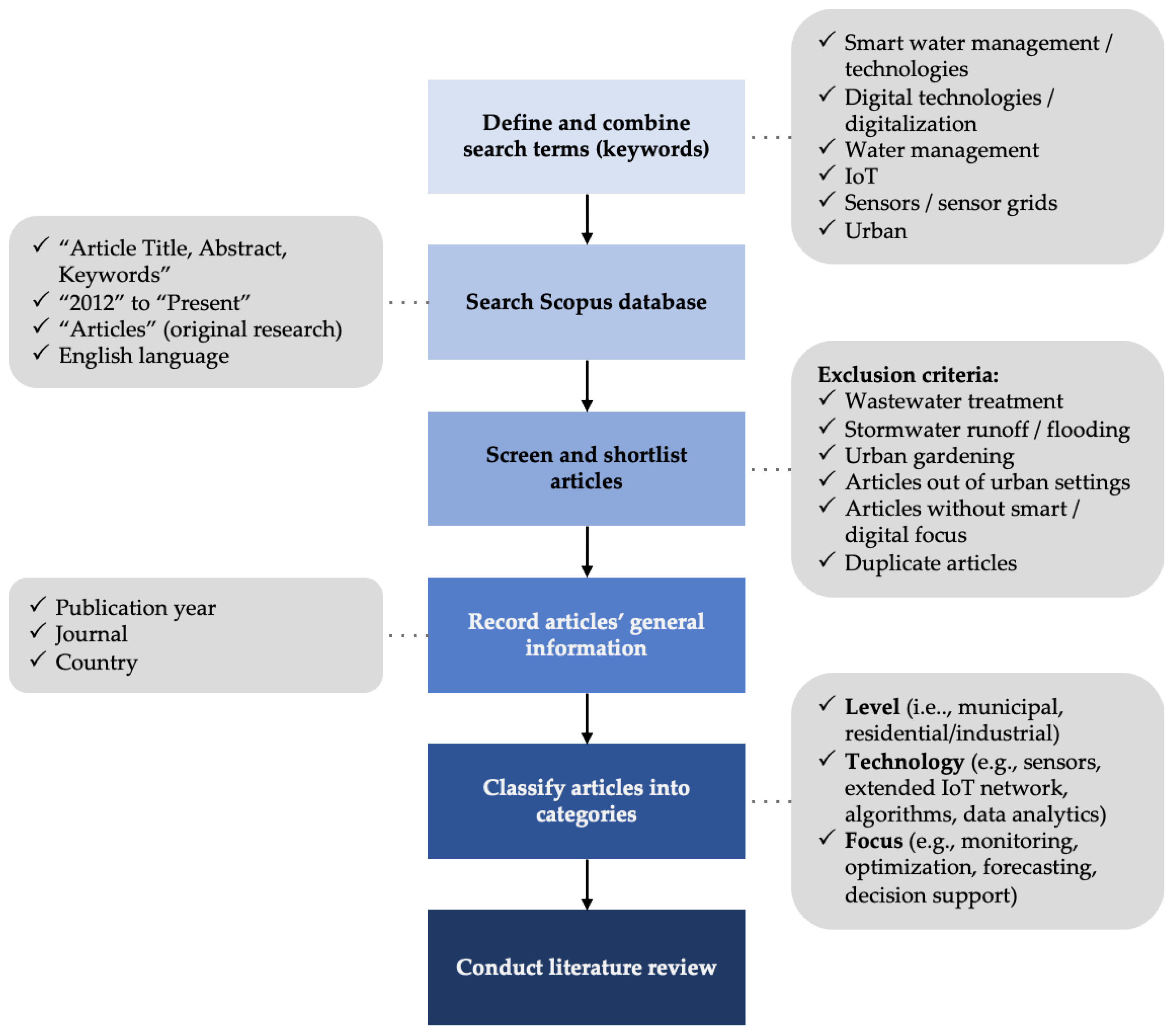
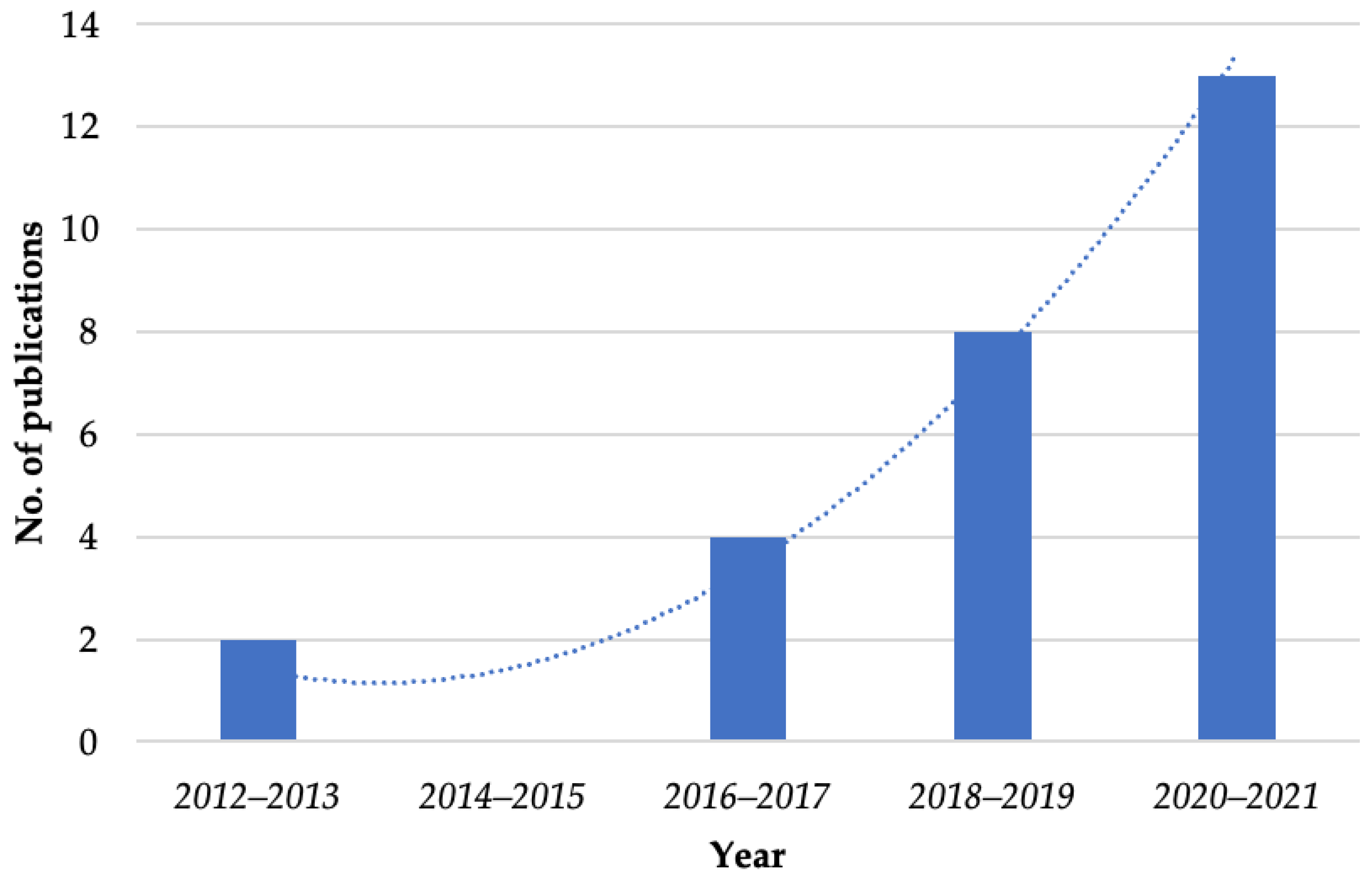
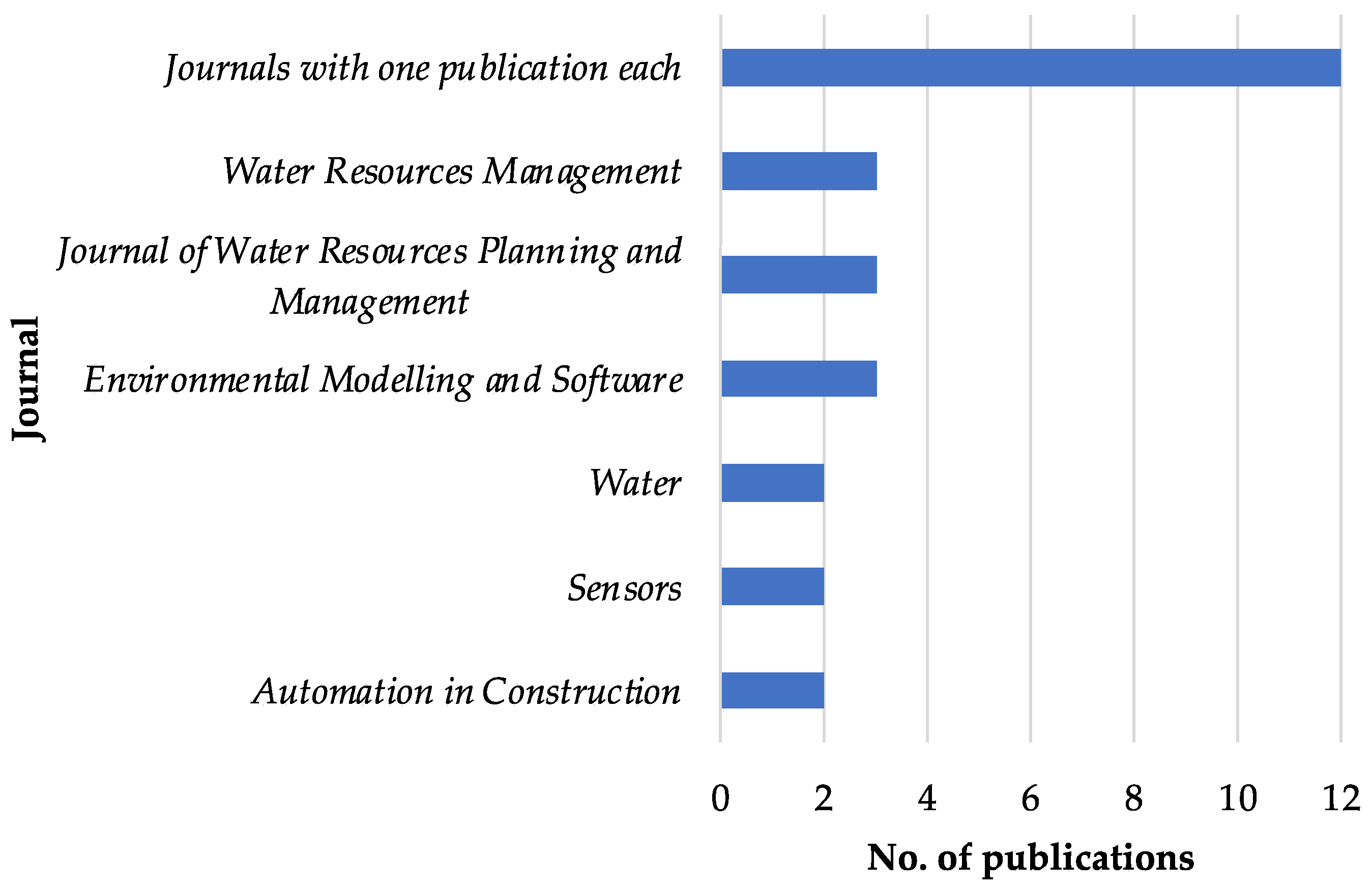
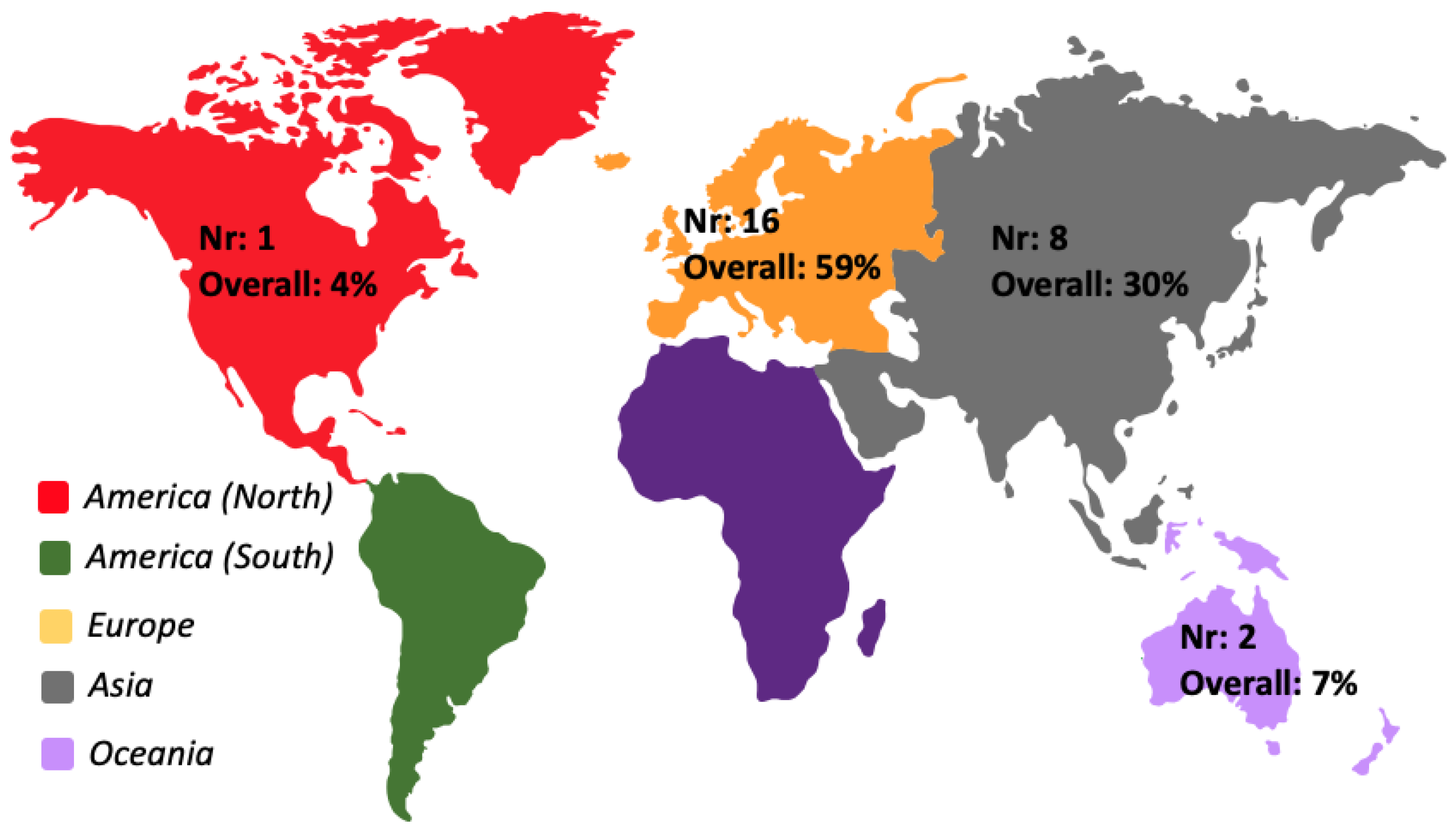

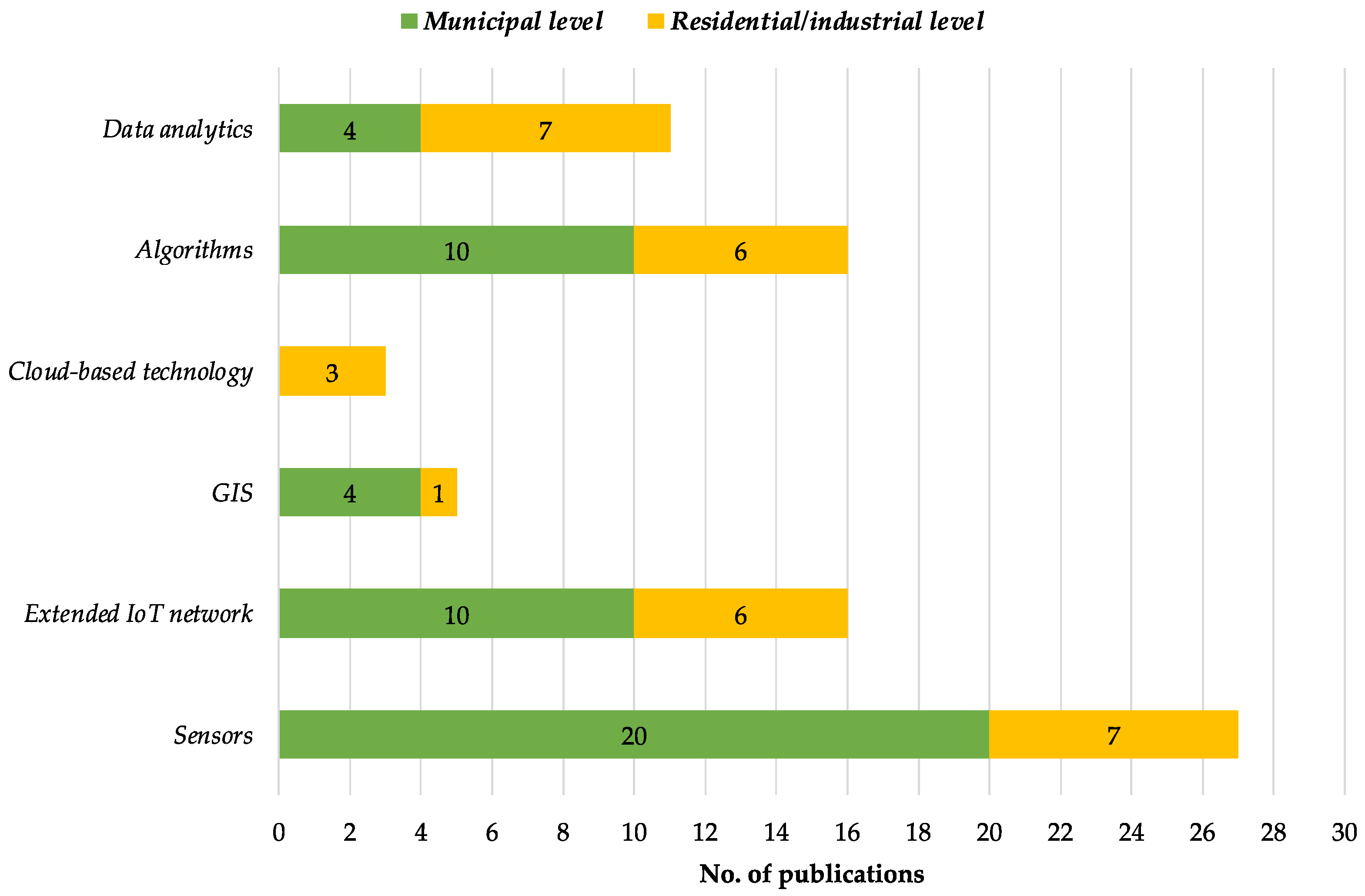
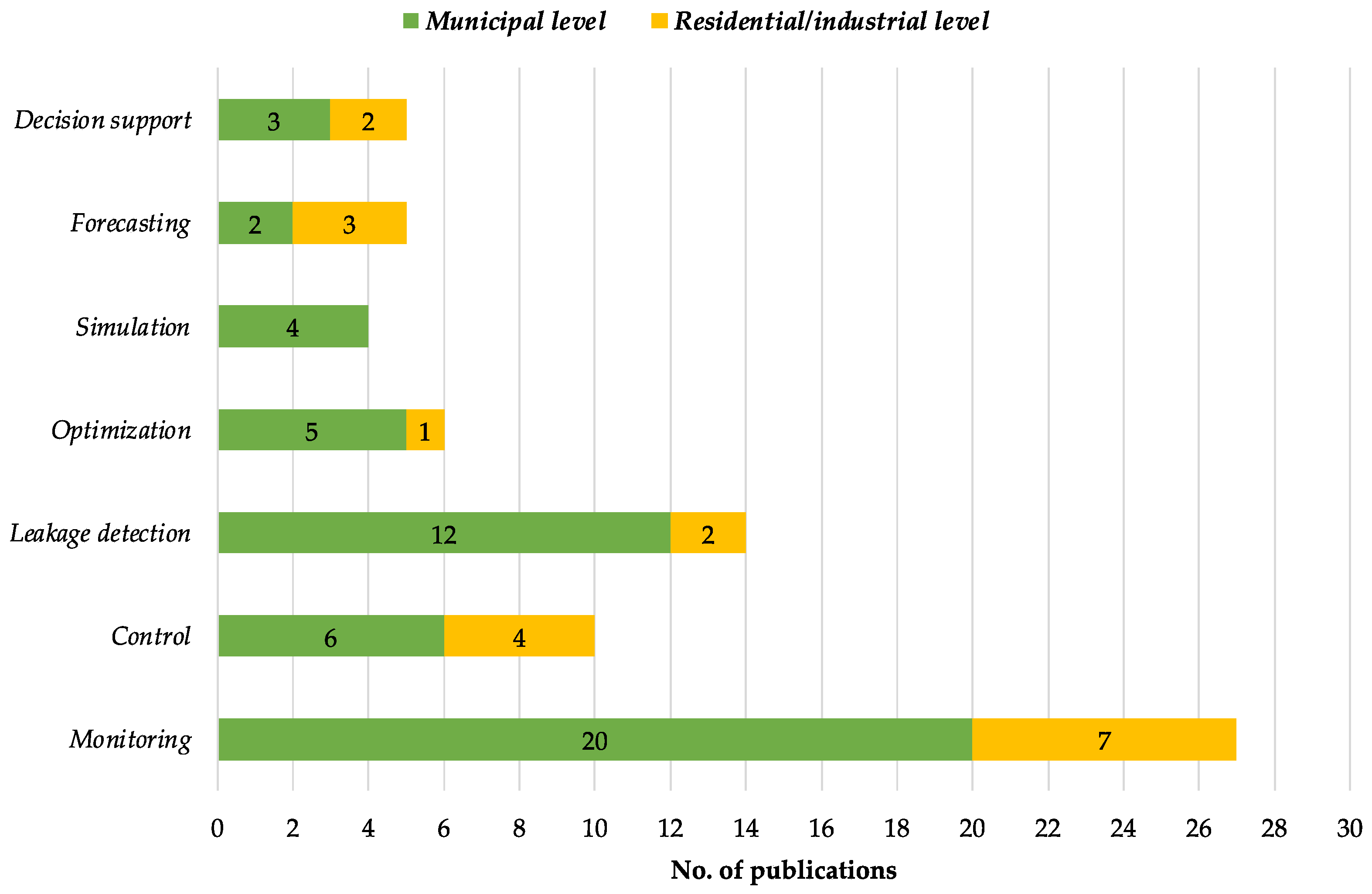
Publisher’s Note: MDPI stays neutral with regard to jurisdictional claims in published maps and institutional affiliations. |
© 2021 by the authors. Licensee MDPI, Basel, Switzerland. This article is an open access article distributed under the terms and conditions of the Creative Commons Attribution (CC BY) license (https://creativecommons.org/licenses/by/4.0/).
Share and Cite
Aivazidou, E.; Banias, G.; Lampridi, M.; Vasileiadis, G.; Anagnostis, A.; Papageorgiou, E.; Bochtis, D. Smart Technologies for Sustainable Water Management: An Urban Analysis. Sustainability 2021, 13, 13940. https://doi.org/10.3390/su132413940
Aivazidou E, Banias G, Lampridi M, Vasileiadis G, Anagnostis A, Papageorgiou E, Bochtis D. Smart Technologies for Sustainable Water Management: An Urban Analysis. Sustainability. 2021; 13(24):13940. https://doi.org/10.3390/su132413940
Chicago/Turabian StyleAivazidou, Eirini, Georgios Banias, Maria Lampridi, Giorgos Vasileiadis, Athanasios Anagnostis, Elpiniki Papageorgiou, and Dionysis Bochtis. 2021. "Smart Technologies for Sustainable Water Management: An Urban Analysis" Sustainability 13, no. 24: 13940. https://doi.org/10.3390/su132413940
APA StyleAivazidou, E., Banias, G., Lampridi, M., Vasileiadis, G., Anagnostis, A., Papageorgiou, E., & Bochtis, D. (2021). Smart Technologies for Sustainable Water Management: An Urban Analysis. Sustainability, 13(24), 13940. https://doi.org/10.3390/su132413940











